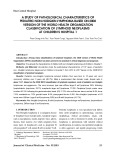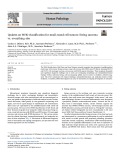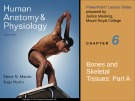
Classification of bones
-
Non-Hodgkin lymphoma is a malignant disease of lymphoid tissue (lymph nodes, lymphoid organs such as nasopharynx, tonsils, digestive tract, spleen, thymus, bone marrow, etc) which originates from many types of lymphocytes such as progenitor B cell, progenitor T cell, mature B cell or mature T cell. To evaluate the characteristics of children with non-Hodgkin lymphomas at Children’s Hospital 1.
 7p
7p  vinatisu
vinatisu
 29-08-2024
29-08-2024
 0
0
 0
0
 Download
Download
-
The WHO Classification of Soft Tissue and Bone Tumours currently recognizes four categories of undifferentiated small round cell sarcoma: Ewing sarcoma, round cell sarcoma with EWSR1-non-ETS fusions including NFATc2 and PATZ1, CIC-rearranged sarcoma, and sarcoma with BCOR genetic alterations. These neoplasms frequently pose significant diagnostic challenges due to rarity and overlapping morphologic and immunohistochemical findings.
 13p
13p  maitrangytb_94
maitrangytb_94
 24-07-2024
24-07-2024
 11
11
 3
3
 Download
Download
-
Lecture Human anatomy and physiology - Chapter 6: Bones and skeletal tissues (part a). When you finish this chapter, you should: Describe the functional properties of the three types of cartilage tissue, locate the major cartilages of the adult skeleton, explain how cartilage grows, name the major regions of the skeleton and describe their relative functions, compare and contrast the four bone classes and provide examples of each class,...
 41p
41p  tangtuy07
tangtuy07
 02-04-2016
02-04-2016
 46
46
 3
3
 Download
Download
-
Definition and Differential Diagnosis PRCA is characterized by anemia, reticulocytopenia, and absent or rare erythroid precursor cells in the bone marrow. The classification of PRCA is shown in Table 102-4. In adults, PRCA is acquired. An identical syndrome can occur constitutionally: Diamond-Blackfan anemia, or congenital PRCA, is diagnosed at birth or in early childhood and often responds to glucocorticoid treatment; a minority of patients have etiologic mutations in a ribosomal RNA processing gene called RPS19.
 5p
5p  thanhongan
thanhongan
 07-12-2010
07-12-2010
 76
76
 4
4
 Download
Download
-
Bone Sarcomas Incidence and Epidemiology Bone sarcomas are rarer than soft tissue sarcomas; they accounted for only 0.2% of all new malignancies and 2370 new cases in the United States in 2007. Several benign bone lesions have the potential for malignant transformation. Enchondromas and osteochondromas can transform into chondrosarcoma; fibrous dysplasia, bone infarcts, and Paget's disease of bone can transform into either malignant fibrous histiocytoma or osteosarcoma.
 5p
5p  konheokonmummim
konheokonmummim
 03-12-2010
03-12-2010
 93
93
 4
4
 Download
Download
-
Classification Approximately 20 different groups of sarcomas are recognized on the basis of the pattern of differentiation toward normal tissue. For example, rhabdomyosarcoma shows evidence of skeletal muscle fibers with cross-striations; leiomyosarcomas contain interlacing fascicles of spindle cells resembling smooth muscle; and liposarcomas contain adipocytes. When precise characterization of the group is not possible, the tumors are called unclassified sarcomas. All of the primary bone sarcomas can also arise from soft tissues (e.g., extraskeletal osteosarcoma).
 5p
5p  konheokonmummim
konheokonmummim
 03-12-2010
03-12-2010
 99
99
 7
7
 Download
Download
-
Table 84-1 TNM Classification for Head and Neck Cancer (Except Nasopharyngeal) Primary Tumor Site T Grade Oropharynx Hypopharynx T1 0–2 cm 0–2 cm T2 2.
 5p
5p  konheokonmummim
konheokonmummim
 03-12-2010
03-12-2010
 84
84
 6
6
 Download
Download
-
Uremia. The red cells in uremia may acquire numerous, regularly spaced, small spiny projections. Such cells, called burr cells or echinocytes, are readily distinguishable from irregularly spiculated acanthocytes shown in Fig. 58-11. Figure 58-11 Spur cells. Spur cells are recognized as distorted red cells containing several irregularly distributed thornlike projections. Cells with this morphologic abnormality are also called acanthocytes. (From Hillman et al.) Reticulocyte Count An accurate reticulocyte count is key to the initial classification of anemia.
 5p
5p  konheokonmummim
konheokonmummim
 03-12-2010
03-12-2010
 62
62
 3
3
 Download
Download
-
Erythropoietin levels in response to anemia. When the hemoglobin level falls to 120 g/L (12 g/dL), plasma erythropoietin levels increase logarithmically. In the presence of renal disease or chronic inflammation, EPO levels are typically lower than expected for a particular level of anemia. As individuals age, the level of EPO needed to sustain normal hemoglobin levels appears to increase. (From Hillman et al.
 5p
5p  konheokonmummim
konheokonmummim
 03-12-2010
03-12-2010
 77
77
 3
3
 Download
Download
CHỦ ĐỀ BẠN MUỐN TÌM





















